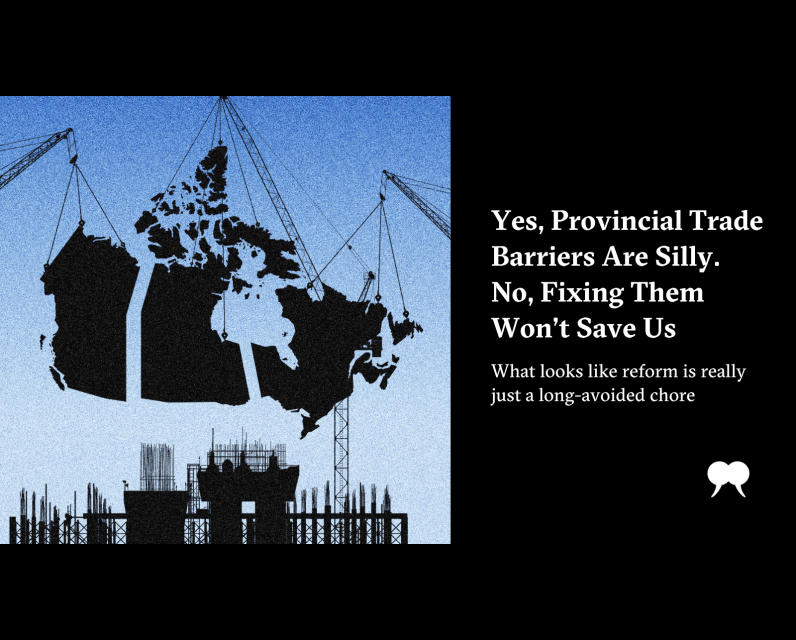Yes, Provincial Trade Barriers Are Silly. No, Fixing Them Won’t Save Us

Many of us are familiar with the meme that goes: “Finally did the thing that I put off forever, and it took five minutes.” The line resonates because the aversion to starting something that seems big or complex tends to be irrational. The hardest part is simply getting started.
That’s sort of what Canada is doing as it fervently tries to harmonize, and in some cases eliminate, interprovincial trade barriers. The fear is that inconsistent rules across provinces—covering everything from products to professional credentials—add needless expenses for businesses trying to operate nationally. A more seamless domestic market would help Canadian companies to grow at home, making them less dependent on selling abroad. Prime Minister Mark Carney is leading the charge to knock down these barriers with Bill C-5, his government’s marquee legislation on internal trade. But the effort falls well short of transformative reform. It’s more like a long-avoided chore that we’re finally getting around to, not because it’s all that urgent but because it’s a manageable way to inch away from our reliance on the United States.
Talk of easing interprovincial trade has been around since the 1980s, when the Macdonald Commission urged a more unified approach to economic policy. In 1995, Canada signed its first deal on the issue, the Agreement on Internal Trade. That was replaced in 2017 with the Canadian Free Trade Agreement. More recently, federal budgets from 2021 through 2024 have all included measures aimed at making it easier to do business within our own borders. In principle, there’s long been political consensus. In practice, protectionism keeps winning.
Liberalizing interprovincial trade holds plenty of econometric promise, but also no small amount of wishful thinking. The idea rests on a handful of optimistic estimates. In 2019, the International Monetary Fund projected full liberalization could boost gross domestic product by as much as 4 percent, though that’s a best-case scenario. These calculations treat regulatory differences between provinces as if they were hidden tariffs quietly inflating the cost of goods and services. Economists then use trade data to model the economic impact of removing those barriers. That’s how you get the rosy projections for growth and productivity.
Much of the skepticism around those projections comes down to how gains are calculated. The IMF report, for example, assumed that if provinces traded with each other the way they do with the US, prosperity would soar. But when CIBC looked more closely at the IMF’s modelling, it found serious flaws. The IMF concluded, for example, that some provinces face more domestic trade barriers than international ones—without factoring in that, say, New Brunswick trades more easily with nearby Maine than far-off Ontario. Worse still, the analysis padded the numbers by including non-tradable services like barber shops and hotel stays.
The Canadian Centre for Policy Alternatives followed up with a critical look, charging that internal trade is largely deregulated already and any legislation is mostly symbolism disguised as minor tweaks. The CCPA report also describes various risks to vital public policies (particularly in environmental protection, labour rights, and consumer safeguards) and cautioned that stripping certain exceptions can actually undermine government authority.
Will that be enough to take the sheen off the scheme? The push for internal trade is happy talk, at best: soothing political language that suggests progress while avoiding the harder, more necessary work of structural reform—all without delivering any of the hyped economic benefits.
But even if the rhetoric is oversold, the problem runs deeper: we hardly know what we’re trying to fix. We don’t have a clear, shared sense of the barriers standing in the way. If we did, this could be a national learning moment: a chance to discover where odd lobbying carved out irrational protections and where modern labour mobility standards still lag. I’m sure that antiquated liquor laws, obscure truck-loading regulations, or tensions about non-standard toilet seats are frustrating. I’m all for common standards. But it’s hard to draw a straight line between port-o-lets and productivity growth. Some of the more bizarre regulatory differences, like how plumbing codes and fixtures differ in British Columbia and Alberta, are as adorable as they are absurd.
But the activity of demolishing these various differentials, while encouraging, is actually emblematic of an intellectual inertia that has come to characterize Canada. In a moment that demands our most ambitious and original thinking, we settle for housework. Now, there can be incredible catharsis in cleaning. The urge to tidy, perfect, and manage the small spaces we control is often a way to impose some order on a world that feels chaotic. I myself am a prolific Swifferer during times of stress (which is to say: frequently). But you can’t Swiffer your way to a better country.
What we’re witnessing may be more of a litmus test: of how much we can achieve together and how quickly. But it also smacks of comfort politics. In Canada, certain zombie ideas reliably resurface whenever we run low on ambition: breaking supply management, liberalizing telecom through more foreign investment, or, now, eliminating interprovincial trade barriers—ideas that also focus on unravelling instead of building. These familiar debates about whether and what to backspace distract from more urgent challenges on our policy horizon: how to derive lasting value from increased security spending, how to resist the impulse to export raw natural resources instead of refining them, and how to confront the structural factors driving up the cost of living.
We’ve tried to compensate for a narrowing trade relationship with the US by making it easier for goods to move within our own borders. But that incremental effort does little to counter the broader forces threatening our economic sovereignty and resilience, especially the dominance of US-based firms across key sectors of our economy and the increasing financialization of it.
Is it really worth congratulating ourselves for picking up this file again? Maybe. But there’s also a missed opportunity to interrogate how these inefficiencies came to be and how we’ll avoid recreating them in the future. That is the deeper work that our country is worthy of but is dodging.
Tackling the real deficits and barriers to responsible economic growth would mean facing some uncomfortable truths. We’ve built an innovation system that lets ideas—and their potential—escape abroad, a data economy we barely govern, and trade deals that limit our ability to shape policy now and in the future. We continue to rely on outdated economic metrics and have allowed foreign platforms like Netflix, YouTube, Spotify, Meta, and Amazon to become the de facto infrastructure of our digital and commercial lives. Until we address those structural blind spots, no amount of regulatory tidying will deliver the transformation we keep promising.
If we’re so hot for better competition and interoperability, then we should extend this ambition to the digital sphere. Self-preferencing by dominant platforms—where a company promotes its own products or services over those of competitors within its marketplace—is the modern equivalent of a province slapping a hidden tariff on something. The act distorts access to markets and tilts the playing field.
When it comes to e-commerce, Amazon’s marketplace has become a powerful checkpoint. As policy advocate Stacy Mitchell’s latest analysis shows, Amazon now pockets about forty-five cents out of every dollar earned by a third-party seller, generating for the juggernaut roughly $140 billion (US) in fees in 2023 alone. That’s a gatekeeping tax, and it’s exactly what digital trade liberalization could dismantle. While it’s not perfectly identical to a border tariff, these platform fees shape which firms can thrive in Canada’s digital economy and eat into the margins of independent sellers trying to compete.
Harmonization is worth celebrating only if it lays the groundwork for a more capable federation, one where provinces extend industrial policy to address things like junk fees and other anti-competitive practices. Carney seems up to the task, but he hasn’t yet articulated a broader vision for what this kind of coordination could enable.
We’ve seen this before. Take his recent pledge to meet the North Atlantic Treaty Organization’s target of spending 5 percent of GDP on defence by 2026, still without a public plan, or the lack of clarity around balancing the operating budget, or the summer vacation project of finding deep spending cuts. As Globe and Mail columnist Shannon Proudfoot quipped, it’s kind of like promising to lose ten pounds. Something else that I am definitely, totally, ten minutes from getting started on (for real this time).
In the meantime, we Swiffer.
The post Yes, Provincial Trade Barriers Are Silly. No, Fixing Them Won’t Save Us first appeared on The Walrus.


Comments
Be the first to comment